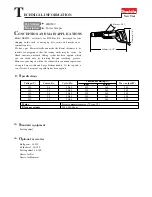
Ultra Tugger
®
Cable Puller and Pulling Packages
Greenlee / A Textron Company
4455 Boeing Dr. • Rockford, IL 61109-2988 USA • 815-397-7070
41
Removing Cable
Removing old cable involves the same principles as
installing new cable. However, there are some important
differences.
Pulling Force
It is difficult to predict the amount of pulling force neces-
sary to remove an old cable. The cable may be damaged,
and it may break with an unexpectedly low pulling force.
The required pulling forces may be very high:
The cable has probably “taken a set.” Unlike the
new cable on a reel, cable in conduit has probably
been in the conduit for years, or perhaps decades.
The cable will resist bending and straightening as
it is pulled through the conduit.
The pulling lubricant has probably hardened,
increasing pulling resistance.
The insulation may be damaged and the cable
may be corroded.
Dirt or other foreign matter may have entered the
conduit and may have cemented the cable in place.
Using a Force Gauge
When pulling old cable out of a conduit, the pulling force
will be highest when
starting
the pull. Select a cable
puller and pulling components to meet or exceed the
estimated amount of pulling force necessary to remove
the old cable. Because breaking the cable free will
require the largest amount of pulling force, it is neces-
sary to use a force gauge to prevent overloading the
system components. Select either the 01069 Standard
Force Gauge or the 00967 Deluxe Force Gauge.
Carefully monitor the pulling force at the force gauge;
if the puller is not able to begin the pull, shut off the
puller and disassemble the setup. Start over with a
puller and components of a higher force rating.
•
•
•
•
Puller Placement
Pulling out old cable is generally accomplished with the
puller located some distance away from the end of the
conduit. This allows the pulling crew to pull out a long
section of cable before turning off the puller, cutting
off the cable, and reattaching the grip(s). Mounting the
cable puller a distance away from the end of the conduit
increases the amount of exposed rope, which greatly
increases the amount of violent whipping action which
would occur if the rope were to break.
To isolate the operator from the rope path:
Locate the puller so that you will stand behind an
obstruction, such as a wall. Set up the puller so
that you will be able to maintain control of the pull.
You need a clear view of the rope as it feeds onto
the capstan, including several feet of the rope in
front of the capstan. You must be able to turn off
the puller before the pulling grip, connector, or
swivel contacts the capstan.
Use an additional pulling sheave (if necessary)
to change the direction of the tailing rope. Anchor
the sheave so that you are close enough to main-
tain control of the pull. You need a clear view of
the rope as it feeds onto the capstan, including
several feet of the rope in front of the capstan.
You must be able to turn off the puller before the
pulling grip, connector, or swivel contacts the
capstan.
Note: Use the additional pulling sheave to change
the direction of the tailing rope (after the rope
leaves the capstan). Do not change the direction
of the pulling rope.
Use a longer tailing rope than usual and stand
away from the puller. Stand as far from the puller
as possible, while maintaining control of the pull.
You need a clear view of the rope as it feeds onto
the capstan, including several feet of the rope in
front of the capstan. You must be able to turn off
the puller before the pulling grip, connector, or
swivel contacts the capstan.
•
•
•
















































